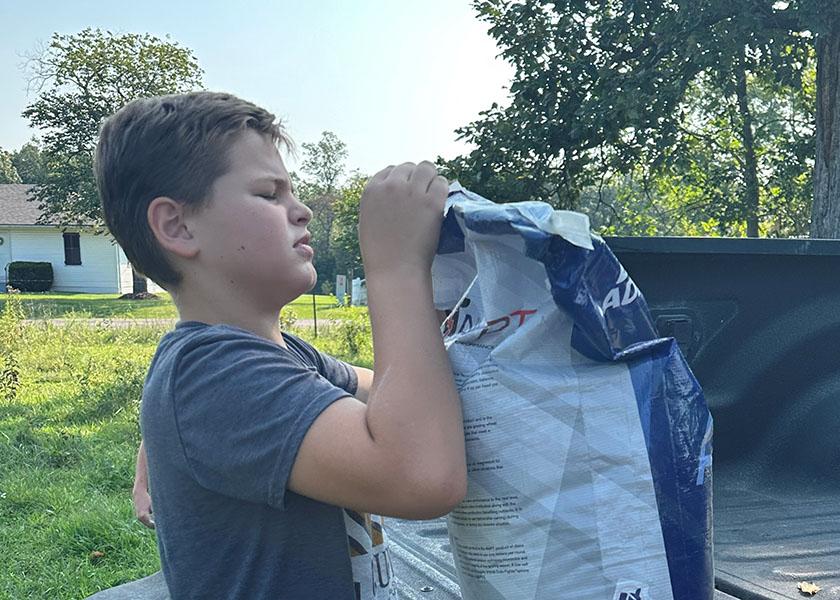Farm Stress Affects Kids, Too: Here’s What You Need to Know

The stress farmers experience is real. With so many factors impacting a farmer’s daily life that are out of their control, it’s no wonder they often experience higher levels of anxiety and depression compared to the general population. But experts point out that little is known about the effects on their families.
A recent University of Illinois Urbana-Champaign study explores how economic stressors affect the mental health of U.S. farmers and their adolescent children. With many young people growing up on a farm and participating in agricultural work, it’s time to look at how stress affects kids, too, says Josie Rudolphi, assistant professor in the Department of Agricultural and Biological Engineering, part of the College of Agricultural, Consumer and Environmental Sciences and The Grainger College of Engineering at the U of I.
Children Are Not Immune to Stress on the Farm
“We've long acknowledged the inherent hazards of this work environment, and now we’re also recognizing its impact on mental health,” she says. “Most of the work on farm stress and mental health is primarily focused on adult farmers. However, it is important to recognize that children are fully aware of what’s happening on the farm, and they are not immune to the stressors that exist,” she adds.
Rudolphi and co-author Richard Berg, analyst at the Marshfield Clinic Research Institute, reveal results from the first year of a five-year study funded by the National Children’s Center for Rural and Agricultural Health and Safety. Through online surveys with farmers and their adolescent children across the U.S., researchers gathered data to dig into this topic more.
They used the Family Stress Model, developed in Iowa in the 1990s after the farm crisis, to examine the correlation between economic stressors and mental health in farmers.
Rudolphi and Berg discovered about 60% of both adults and adolescents met the criteria for at least mild depression, while 55% of the adults and 45% of the adolescents met the criteria for generalized anxiety disorder.
“Prevalence of depression in the general population is typically around 17% to 18%, so these numbers are quite high. Although we don't have a control group for direct comparison, we used similar instruments to screen for mental health conditions as national public health surveys. Additionally, these statistics are not unusually high for a farm sample, based on previous surveys with farmers,” Rudolphi says.
Is a Stressful Life the ‘New Normal’?
When evaluating economic hardship indicators, farm debt showed a high correlation with depressed mood in adults, and this in turn was correlated with adolescent depression and anxiety.
“It’s not unexpected for children to be affected by the experiences of adults. In many other settings, adults can leave work, return home, and transition into their roles as parents. But in a farm environment, the boardroom table is the kitchen table, and there is talk about farm activity in the household. There’s a blur between work and family, or business and residence, so it becomes rather complicated,” Rudolphi says.
Still, despite 82% of respondents rating their own mental health as excellent or good, their responses to questions measuring symptoms of anxiety and depression revealed different results. Rudolphi says this may be because people may have become accustomed to living with mild or moderate depression, perceiving it as their new normal.
Are Adult and Adolescent Depression Linked?
The researchers are in their third year of data collection, and continue to expand the number of participants. Their goal is to establish stronger connections between economic stressors and mental health in future data analyses.
One of the most important findings in the current study is the strong correlation between adult depression and adolescent depression, Rudolphi points out. This underscores the need to develop resources and services for the entire farm family.
Although there is a growing library of mental health resources available for farmers, they mostly target the owner-operators. Not kids.
“We must also consider the well-being of spouses and children on the farm,” Rudolphi says. “The agricultural environment prides itself on looking out for one another. We should harness that shared responsibility to foster a sense of community and support for young people. This involves engaging with rural schools, teachers, coaches, and agricultural youth leaders in mental health awareness initiatives.”
Rudolphi is co-director of the North Central Farm and Ranch Stress Assistance Center, a 12-state, 15-partner collaborative based in Illinois Extension that offers stress management and mental health interventions.
Editor’s Note: The article, “Mental health of agricultural adolescents and adults: Preliminary results of a five-year study,” is published in Frontiers in Public Health [DOI: 10.3389/fpubh.2023.1056487]. Authors are Josie Rudolphi and Richard Berg. The research is funded by the National Children's Center for Rural and Agricultural Health and Safety (NCCRAHS), National Institute for Occupational Safety & Health (NIOSH) grant # U54 OH009568-11.
Click here to download the eBook "Your Guide to Mental Health."
Read More about Mental Health & Wellness:
Mental Health on the Farm: One Swine Production Manager's Story
By Her Own Hand: A Farm Girl’s Miraculous Journey from Death to Hope
Pay Attention to Warning Signs of Stress
Lack of Understanding Leads to Loneliness in Farmers
Toxic Grit: Is Our Greatest Strength Our Greatest Weakness on the Farm?
Connect With Farmers In-Person On Mental Health
Simple, Daily Habits to Help Manage Stress







